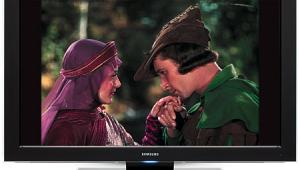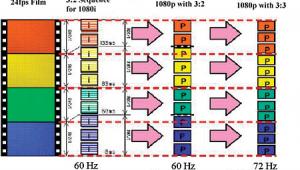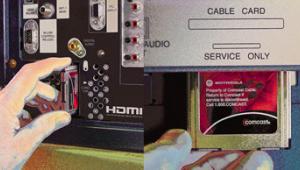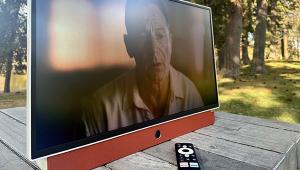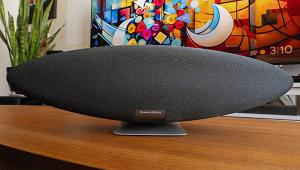Unless you have a screen filling an entire wall where everyone viewing would be inside the curve these make no sense to me.
State of the Arc: Curved Screens Are Here, But Why?
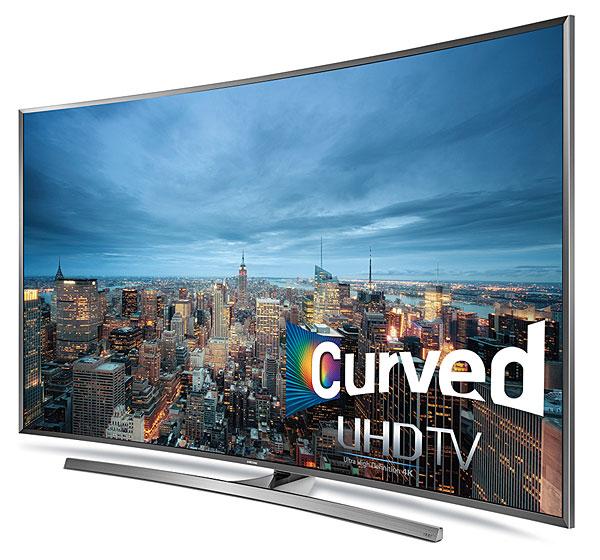
Curved screens are so new that you can’t really call the phenomenon a bona fide trend just yet, observed Paul Gagnon, director of TV for IHS Technology (formerly NPD Display-Search), a research firm with expertise in the television market. “There’s a trend in that it went from nothing in 2013 to something in 2015,” he said, noting that IHS expects curved TV shipments of 700,000 to 800,000 in the U.S. this year—about 2 percent of the total market. “As we look at the curved marketplace as a whole, we’re curious to see if it takes root considering there is really only one proponent [Samsung] kind of creating the category.”
Indeed, 2015 is shaping up to be a pivotal year for curved screens. Over the next 12 months, we’ll learn whether they have what it takes to capture the imagination of a fickle TV-buying public driven largely by price. But for now, there’s a more pressing question: Why curved screens in the first place? Do they bring tangible benefits to the viewing experience, or is the curve simply cosmetic?
Doubling Down
In what amounts to its most ambitious offering to date, curved screen models account for about half of Samsung’s 2015 UHD TV lineup or about a quarter of all models. As of this writing, two dozen curved-screen models in sizes from 55 to 78 inches were listed on the company’s Website. Most are new models, a few of which were not yet available, and all but one are 4K/Ultra HD (UHD) resolution.
 |
Dan Schinasi, Samsung |
“There’s also more of a sweet spot to the TV,” Schinasi continued. “A lot of folks say, it’s curved so therefore it’s distorted. There’s actually less [geometric] distortion. We’ve done extensive studies with UC Berkeley to look at the perception of objects on a curved screen to discern when and if they can’t be comprehended. As long as you’re not at the very extremities and looking at the screen from anywhere in that sweet spot, even from the left or right side, a curved screen actually delivers less geometric distortion than a flat screen. That translates into more ideal viewing conditions.” (More on this in a moment.)
Having sung the praises of curved TVs, Schinasi is quick to point out that the company also sells plenty of flat screens. “If there’s a strong preference for one or the other, we have it.”
Academia Weighs In
The study Schinasi refers to was conducted in conjunction with Martin Banks, professor of optometry and vision science at the University of California, Berkeley and principal investigator at the Visual Space Perception Laboratory, and Marina Zannoli, PhD, a postdoctoral researcher at the university. We contacted Banks and Zannoli to learn more about the study’s findings on how a curved screen affects field of view, reflections, and geometric distortion.
 |
Martin Banks, UC Berkeley |
What does the expanded field of view mean in the real world? “We found that an increase in field of view does have a positive effect on immersion,” Banks said. “Does a 4-percent increase have a positive effect on immersion? I don’t know. A tad unlikely, but in the right direction, anyway.”
 |
Marina Zannoli, UC Berkeley |
Geometric Distortion. The relationship between a curved screen and geometric distortion is more complicated. “We focused in the research on what’s called the wide-angle distortion that people can see with widescreen panels,” Banks explained. “Even though images presented on the screen may be correct in shape for a person at the recommended position, viewers tend to see objects near the edge of the screen as distorted. The critical thing is what we call the slant angle. Imagine a line coming out perpendicular from the point on the screen that we’re looking at (somewhere off to the side). Imagine another line from the viewer’s eye to that point. The slant angle is the angle between those lines. When that angle becomes greater than 30 degrees, perceptual distortions start to arise. When the screen is curved, the slant angle is reduced, so an object on the screen will appear to be less distorted than it would have been when viewed on a flat screen.”
Curved, Schmurved
Vizio, the second largest seller of TVs in the U.S. behind Samsung, wants nothing to do with curved screens and even went so far as to produce a fake ad entitled “Revolutionary Anti-Curved Glasses” that pokes fun at curved screens. Done in the style of a hard-sell TV pitch offering “anti-curve glasses [that] turn your curved TV into a beautiful flat screen,” the ad opens with a man holding his head and grimacing while a voiceover asks: “Is your new curved TV causing you frustration?” The video logged more than 205,000 hits in three months.
John Hwang, director of product management, HDTV, explained: “We wanted to point out in kind of a humorous way some of the things we think of and have experienced with curved screens to kind of send a message to consumers that says, hey look, our focus is to improve the overall experience, and we feel from a Vizio viewpoint that curved TVs do not do that.”
In making the argument against a curved screen, Hwang said, “The most obvious thing you don’t see is a uniform image. Even from a front view, you’re not seeing a rectangular-shaped screen—it’s kind of bowed at the top and bottom, and when viewed from different angles the picture gets distorted pretty massively in a nonuniform way. Even with a flat screen, if you go off angle, you’re skewing the image, but you’re skewing it in a more natural perspective as opposed to an unnatural curved perspective.”
Hwang also takes issue with the often-heard statement that a curved-screen TV can deliver a more immersive experience than a flat-screen set with the same screen size. “Unless we’re talking about an extremely large IMAX-like screen, the curve doesn’t really deliver the whole immersive experience that’s promised by some manufacturers.” He also claims curved-screen sets that use full-array direct LED backlighting—which Vizio is introducing across its entire lineup—exhibit “some extremely strange moiré effects. We’re curious to see if some of the competitive products incorporate technology that solves this.”
A Happy Medium
At LG, which holds the number three position in U.S. TV sales, curved screens are reserved for its growing line of OLED TVs, which comprises five new UHD OLED models with screen sizes from 55 to 77 inches.
 |
Tim Alessi, LG |
Although LG makes curved LCD TVs, it does not sell them in the U.S. “We decided to keep our regular LCD lineup all flat,” Alessi explained. “There are some downsides to curving a TV screen—with reflectivity, with viewing angles, especially with a non-IPS (in-plane switching) screen [IPS panels provide a wider viewing angle than the VA, or vertical alignment, technology used by Samsung]. We’ve done a lot of side-by-side comparisons between our curved OLED and some of the competitive curved LED screens, and there are distinct differences in picture quality, especially when you get a little bit off axis. OLED doesn’t have the narrow sweet spot like an LCD does.
“If you were to compare an OLED and LCD side by side, both curved, the superior black level and viewing angles of OLED is what’s going to strike you right away, even if you get just a little off axis,” Alessi continued. “Now, if you were to do detailed measurements, it may come out that the color accuracy is better as well. When you curve an LCD, you’re taking something that was meant to be flat and curving it so there’s the possibility of misalignment and light going through adjacent color filters simultaneously, which means color may not be as accurate, whereas OLED makes its own light, so you don’t have any of those issues.”
Like many, Alessi sees aesthetics as the primary benefit of a curved TV screen. “If you read a lot of the reviews, for example, I think the general consensus among the expert community is that a curved screen doesn’t really add anything to the picture, and most people seem kind of happy that it doesn’t detract from it as much as they thought. So I think it’s mainly an aesthetic thing. When you get to the larger screen sizes, there is an immersiveness of the picture that appeals to some people. It does kind of draw you in a little bit, especially when I see our 65-inch OLED, but it’s more of a personal choice.”
What About Sony?
How about Sony, which introduced the first curved-screen TV in 2013 but has since pulled back on the category. What’s its current stance on curves?
Taka Fujita, vice president of home entertainment, said in a statement: “There are benefits to curved TVs and benefits to flat TVs. While Sony was the first to introduce a curved TV to market and does now offer a curved model in other regions, we do not currently plan to carry these models in the U.S. We look at each market individually and determine our product offerings accordingly. In the U.S., most people tend to hang their TVs on a wall, so an ultra-thin [flat] TV integrates better into the American lifestyle. Sony will continue to evaluate the market and will consider introducing curved TVs again in the U.S. when we think the market conditions are appropriate.”
The Big Push
Samsung has come out swinging and appears intent on building a market for curved-screen TVs, leaving some industry pundits to wonder if there’s more to the story than the obvious desire to be different.
 |
Stephen Baker, NPD |
IHS’s Gagnon has another theory.
“OLED has been a topic of great interest by both Samsung and LG. Both companies have been talking about it as the next generation of display technology for many years. I think it’s quite clear at this point that LG has figured OLED out with their solution, but for Samsung, it’s back to the drawing board. So rather than cede new technology to LG, they’ve become one of the leaders of being able to do curved LCDs. And, oh, by the way, it’s quite difficult for LG to curve LCDs because of the IPS panel technology they use.”
 |
Paul Gagnon, IHS |
Convincing consumers to pay the higher price commanded by curved screens is a huge challenge, he added. “From our point of view, we see the curved attribute as being more related to design and aesthetics than an improvement in consumer enjoyment. And as a result, it’s subject to things like fashion, and you know fashion is in the eye of the beholder. It’s tough to ask the consumer to pay 300 bucks more for this TV that has a fashionable attribute.”
But Schinasi said price premiums are not “quite that black and white.” The higher pricing on some of Samsung’s curved-screen TVs is not just for the screen. “It’s also for the step up to 4K in many instances and the TV performance itself—the backlight performance, which contributes to brightness and color accuracy.”
Another factor is the material cost of curved panels. “We know curved panels themselves carry a roughly 20 to 30 percent premium,” Gagnon noted, “which leads me to believe Samsung is not making much money on curved sets.”
Curved Here to Stay?
“I think curved screens will have staying power,” said Brian Markwalter, senior vice president of research and standards for the Consumer Electronics Association, producer of CES, the world’s largest consumer technology show.
 |
Brian Markwalter, CEA |
NPD’s Baker thinks it’s too early to tell whether curved TV will prevail but said, “My gut is that it has more legs than 3D. Whether or not it really adds value, I’ll let consumers decide if they see a value proposition there.”
“I have a difficult time saying curved—a design-related attribute—is something you can capture a premium for in the market,” said IHS’s Gagnon, but he acknowledged that it’s still too early to make a call one way or the other.
Retailers we spoke with report success selling curved TVs and seem to have bought into the notion of curved screens presenting a more immersive experience. “IMAX-like” came up in conversations with Best Buy, the country’s largest electronics retailer, and Indianapolis-based hhgregg, which operates 228 stores in 20 eastern states.
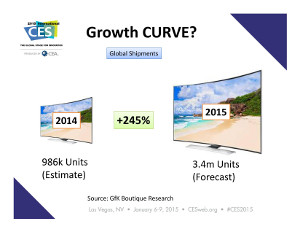 |
The Consumer Electronics Association and GfK Research are predict big growth for curved screens in 2015. |
Best Buy doesn’t comment on sales, but a spokesperson said “a curved TV is something many customers look for” and noted that they are “primarily part of our premium HDTV assortment. Because of this, our Ultra HD and OLED products are really the only available models that have a curved screen. For both Ultra HD and OLED, having a curved screen complements the incredible picture quality found in those TVs with an immersive IMAX-like viewing experience. Customers have always gravitated toward technology improvements that focus on picture quality, and the combination of curved screens and Ultra HD/OLED does just that.”

To Curve or Not to Curve
It may be too early to predict if curved-screen TVs will catch on, but we know through our conversations with retailers that some shoppers are attracted to the design aesthetic, while others have no idea curved screens exist—let alone offer subtle benefits they may or may not perceive—until they see a display or the salesperson directs their attention to one. We also know that many enthusiast readers of Sound & Vision abhor the idea of a curved screen. Will the findings of UC Berkeley’s research sway them? Probably not, but we’ll see. Ultimately, the success of curved TVs will come down to whether the TV-buying public relates to the modern aesthetic and thinks it can bring value to the entertainment experience. And, as LG’s Tim Alessi noted, that’s a personal choice.
- Log in or register to post comments


Exactly. Even IMAX doesn't use them (at least the one I go to doesn't).

Curved screens don't make much sense to me for TVs in a living room space. For a wall-sized projector screen, sure, but it seems like the FOV on a TV that you're sitting 8-10 feet away from is just going to be too small to benefit from the curve, especially if you have seating positioned around the room outside of the sweet spot. I guess if you have a small room with limited seating so all of the seats are directly in front of the screen, and you're close enough to the screen to get a wide FOV on it, it might make sense.
One area curved screens do interest me is with large computer monitors, because the close seating distance means a computer monitor takes up a far wider field of view than a TV in a living room does, and you're generally only going to have one person sitting directly in front of it, so you'll always be in the sweet spot.
There are some 35" ultra-wide (21:9 aspect ratio) curved monitors coming out that I'm considering looking into. When you get into monitors that large, the viewing angle of the LCD panel starts to become a big issue, because the sides of the screen can be at such a wide angle from your eyes that you get a noticeable contrast shift at the sides of the screen, even with an IPS panel. A curved panel could help alleviate that.

When you first see a curved screen it is pretty neat. If you stick your face in close to the screen it is really neat how theatrical the screen looks wrapping your head (so-to-speak), but the look from the sofa becomes tiresome over time as it isn't really doing anything but bothering me with it's curves. This idea is too late for it's use in my opinion as it would have been good on those old tv's that got dark on the edges when you had to watch from a steep angle due to lack of seating. The edges turn toward you lessening the darkness. ....darkness being a problem years ago but not anymore.
My Dad just bought a 4K Curved (to futureproof himself I suppose) as he is not a techy guy... He has a big atrium door unit behind his sofa that lets in a lot of bright light, and I noticed that the glare from that stays in the center of the screen as you move from side to side, no matter where you sit.
Not for me. I will go flat when I ever get to upgrade.

Didn't we used to have curved screens? Cathode-ray-tube fish bowl curved screens. I was very glad when flat panel TVs became the affordable norm. Wouldn't a curved screen distort the filmmaker's original intention of how the film is meant to be viewed. Curved screens were experimented with in the cinema when widescreen first came on the scene. It would be interesting to watch films made for that format on this type of screen (E.g. 'How the West Was Won'

When I first saw these curved screens, I thought the same thing myself. I can remember models that were the pre-cursor to the "all in one" RPCRTs in which there was a light box with the red, green and blue picture tubes sitting a couple of feet or so in front of a curved screen upon which the picture was projected. In that respect, I suppose there is nothing really new here.
I have looked at both curved and flat in UHD and in all honesty can't tell the difference. Ultimately, it is always about the quality of the source, the curved element just seems to be a case of marketing and differentiating one brand from the other.
(Now, if I could only come up with the "eight grand" or so to buy that LG 84" OLED).

No matter where you land on the whole curved vs. flat screen debate, no one can provide a legitimate argument for the glossy bezel. While I too have some confusion understanding why we have curved screens again after the industry took such pains to be rid of them, I don't understand why all bezels aren't provided a matte finish. The biggest disappointment I observed viewing the new 65" LG 4K OLED had nothing to do with the curve in the screen - instead I found myself thinking how much better the picture would look if it were not framed by a glossy bezel which picked up and reflected all the ambient light in the local BB Magnolia showroom. And then there's the whole fingerprint thing as well - NOTHING improves with a glossy bezel.

Rather than investing money in curve screen, internet features, etc..., TV manufacture should focus on the basics, the picture quality. It has been more 10 years since the first HDTV flat panel hit the market. We still have TV that can't deinterlace 1080i properly. We still have TV that can't reproduce gray scale, gamma, and color gamut accurately out of the box. Sure, I can calibrate or hire someone to calibrate, but the point is I shouldn't have to.

Exactly! Good points. I would add HDTVs that sense the signal format and automatically set the aspect ratio for the correct display of the input signal- especially for broadcast TV, you'll be surprised how many TV's that by default stretch out the SD image to fit the 16:9 aspect ration!!!

Has always seemed a bit gimmicky to me.
A bad investment for these companies.

Count me out as well, but I give the marketing guys an 'A' for slick presentations for the in store setups. I'll take one on a give-away but I'll never buy one. I'll stick with my Panasonic plasma and its 'inky' black picture and color fidelity. I just bought an Oppo 103D and oh boy! the picture is magnificent.

A study that hasn't been published or peer reviewed? Not worth the pixels written about it. Of course Best Buy and hhgreg are going to say they believe in it, they have committed floor space to sell them. They also belive in expensive HDMI cables. Both quotes even have the same buzzwords.
The sales research is focused on sales to retailers, not sales to consumers, which is how you get bad numbers, such as in the video game industry. Sales were being reported as declining, but they weren't measuring direct sales like Steam.
It's a design attribute, and it may have applications on extremely large screens, but on 50 inch or smaller, I don't see it as a benefit.

The comment of BB salesperson tells you all you need to know about this subject: "...Customers have always gravitated toward technology improvements that focus on picture quality.." That statement is so false, it's not even funny, yet spoken like a true clueless BB salesperson. If it were true, plasma display technology would rule the the TV sales by a wide margin, let alone would still be thriving.

We didn't want 3D. We loved plasma. UHD is largely a stop gap for LED's insufficient images. We don't want curved screens. The marketing guys at Samsung are really stretching to keep the public excited. Even LG has disappointed by first rolling out the curved OLEDs rather than the flat models. Have any idea how many of our customers are holding out for flat 65" LG OLEDs? LG can win the high performance category; Samsung can get...bent.

So what do I get if I'm not in the sweet spot? Aren't the guys sitting to the side already off axis? Wouldn't the money required to pay for a curved screen be better spent buying a larger, higher quality flat screen? For instance one of the top of the range Sony flat screens.
As far as I'm concerned I do not want to pay for market differentiation only rarely improves my viewing experience.

I'm sorry, but I just couldn't stop myself from responding. Sony will never get my money on a large purchase again. I bought a Grand Wega 3LCD rear-pro, rather than a DLP, because I thought Sony was potentially a better product and bought into the "no moving parts" argument. The set died before the first lamp replacement, and it was out of warranty (around 3 years). When I looked up the issue, I found a ton of issues on their projection TVs that mostly all cropped up after my purchase. The Panasonic plasma that replaced it has already lived twice as long.




